Shortcode

il pozzo e il miele
the christian Buddha illustrated book:the well and the honey Let’s...
Read MoreLet’s discover how the Buddha incognito ‘infiltrated’ Christianity.
“il pozzo e il miele” (italian title traslated as”the well and the honey”) is an illustrated book project I have been working on in 2019, based on a parable contained in Barlaam and Joasaf, a tale that has travelled through countries and religions over centuries, captivating people far and wide.
Barlaam and Joasaf conquers Christianity, so much so that its two protagonists become Christian saints, but what are its true origins?
Of the text, the third parable has aroused great interest in writers, philosophers and scholars, giving rise to various interpretations, some very different from each other.
Then I will reveal you what my interpretative choice was for the illustrations.

The dating of the story of Barlaam and Joasaf is uncertain, but it arrived in the West in medieval times around the 10th or 11th century.
The memory of Saints Barlaam and Joasaf in the Roman Martirology falls on 27 November.
Barlaam and Jeasaphat were placed in the Greek Orthodox liturgical calendar on 26 August Julian (8 September Gregorian), and in the liturgical calendar of the Slavic tradition of the Eastern Orthodox Church on 19 November Julian (2 December Gregorian).
story of Barlaam and Joasaf |
story of the Buddha |
| an Indian king, an adamant persecutor of Christianity, celebrates the birth of his heir, but the horoscope of the most illustrious of astrologers states that the prince will leave his crown to follow Christian teachings | the king of the Sakya, an Indian clan, welcomes his newborn heir and astrologers reveal to him that his son has two options: to become the ruler of the world or to abandon court life and become an ascetic, turning into an awakened one. |
|
to prevent this fate, the king had his son isolated in a palace, surrounded only by young and beautiful people, where he was offered all the joys of life |
the king, in order to prevent his son from becoming an ascetic, had him isolated in a palace, surrounded only by young and beautiful people, where he was offered all the joys of life |
|
Ioasaf meets a sick, old man and understands the inevitability of death, then meets the monk Barlaam. His eyes are opened to the condition of life |
prince Siddhartha (future Buddha) comes across a sick man, an old man, a dead man and an ascetic. His eyes are opened to the condition of life |
|
both Ioasaf and his father abandon court life to take up monastic life |
siddhartha left court life to take up asceticism, returned as an awakened man in his clan and provoked the decision for them, including his father, to leave court life and become ascetics under the guidance of the BuddhaLe due storie coincidano per la maggior parte! Non lasciando molti dubbi sul fatto che questi due santi canonici hanno origine nella personalità del Buddha. |
The two stories coincide for the most part! Leaving little doubt that these two canonical saints originate in the Buddha‘s personality.
Reading the preface to “storia di Barlaam and Ioasaf” of Silvia Ronchey it is clear how the appellation of bodhisattva (one who is destined to become a Buddha) has been modified by different cultures as has his true identity: “the Buddha was not called Budasaf, i.e. bodhisattva, as in Bilawhar wa Būḏāsf: he was called Iudasaf. The Well-Guided wanted to read Iuzasaf and thought it was an Arabic variant of the name Jesus .”
It is thus that the story of the bodhisattva, who later became the Buddha, travelled the roads of history and the alleys of cultures, took on a new identity and then landed in Christianity, even becoming twofold in the saints Barlaam and Joasaf. In fact, it appears from the introduction itself, that “Barlaam” was a deformation of the name “Buddha”, so we can say that master and alumnus in the story of Barlaam and Joasaf were in fact the same person, which makes a lot of sense from a Buddhist point of view, as the Buddha was in fact his own master, achieving awakening for himself.
From the introduction of the story of Barlaam and Joasaf we read about another interesting connection between Jesus and the Buddha:
“On this revelation, Ghulam Ahmad founded the Ahmadiyya movement, also called Qadianism, from Qādyān, the Punjab city where the revered masīh was born, lived and preached. This Islamic sect is still widely followed today, although repeatedly disavowed by orthodox Islam. Its doctrine of the ‘Indian Jesus’ has also fascinated Christian denominational literature. It has, of course, aroused stubborn controversy.“
There is certainly a certain fascination with the hypothesis that Buddhism and Christianity are in some way closely related, although there are arguments of doubtful veracity.
In the course of the story of Barlaam and Ioasaf we find the story, which gave rise to my book project, in the third parable, the wayfarer and the unicorn:
“A man is chased by a rampaging unicorn. He cannot bear its terrifying neigh. In his flight he stumbles and falls into a ravine. As he plummets, he stretches out his hands, manages to grab a shrub, clings to it with all his might, puts his feet up and catches his breath. Looking closely, however, he notices that two mice, one white and one black, are gnawing at the roots of the shrub, which are on the verge of giving way. He looks down into the ravine and sees a fearsome dragon waiting for him with its jaws wide open. He looks up to examine where his feet stand and sees four snake heads sticking out of the rock face at that very height. Then he looks up and sees that honey is dripping from the branches of the shrub. He stops thinking about the unicorn chasing him, about the dragon waiting for him, about the fact that the bush he is clinging to is about to give way, about the treacherous base he is propping himself up on: he forgets everything and with all his strength concentrates on the sweetness of that little drop of honey.“
This short story has certainly interested and fascinated many, leading to a whole series of philosophical/religious interpretations and hypotheses, even with one moral being the opposite of the other.
From the analysis of fr. Nieremberg (M.C.Minutiello) and the assessments of the orientalists (S. Ronchey ) we can see how the symbols are interpreted supposedly in this way:
unicorn= the death
ravine= the world
shrub= the human life (from the orientalists)
mice= the passing of time
snakes= the four material elements of the body (or simply the four elements)
dragon= hell
honey= the pleasures of life (or ephemeral pleasures)
Ronchey notes that mice could also be interpreted as good and evil, as far as honey is concerned, he notes that it must come from a beehive, thus having the meaning of the anaesthetising power of ordinary work.
Both Father Nieberg and the Orientalists quoted by S. Ronchey believe that the meaning of the story is that foolish man loses himself in the ephemeral pleasures of life instead of worrying about imminent death.
S. Ronchey also quotes a Zen version, which I looked up at the time I was trying to identify the meaning of the story I was going to illustrate, and found this version:
‘In a sutra, Buddha told a parable: A man walking through a field came across a tiger.
He started to run, tailed by the tiger. When he reached a precipice, he grabbed onto the root of a wild vine and let himself hang over the edge. The tiger sniffed him from above. Trembling, the man looked down, where, at the bottom of the abyss, another tiger was waiting to devour him. Only the vine held him up. Two rats, one white and one black, slowly began to gnaw at the vine. The man spotted a beautiful strawberry next to him.
Grasping the vine with one hand, he plucked the strawberry with the other. How sweet it was!”
The zen meaning here is entirely positive, linked to the protagonist’s ability to centre himself in the present, without regretting the past he has left behind or worrying about the inevitable future for which he can now do nothing.
Again from the introduction to Sivia Ronchey’s:
“Among the moderns, the parable has been read, basically in agreement with the Zen variant, as a eulogy of the courage of those who manage to seize the moment and savour the taste of life while being fully aware of its tragic nature and folly.“
Baudelaire provides four interpretive paths (S.Ronchey):
1 the evil, the unconsciousness (perhaps youthful) that urges one to lick the honey-drops
2 Epicureanism, the taking advantage of the goods at one’s disposal without looking at mice or honey but taking advantage of the good of the moment by being able to enjoy what human life offers
3 the way of strength and action: once one understands the stupidity of life, one chooses to move towards non-being, acting as a ‘demigod’ in the best time of life by putting an end to it
4 the way of weakness: dragging life even knowing it is nothing but continuing to live not having the strength to end it…”
I created this project in 2019 within the “illustration and publishing course” of the Scuola d’Arte e dei Mestieri Nicola Zabaglia, starting with the parable of “the wayfarer and the unicorn”.
After several researches and reflections, it was natural for me to follow zen meaning of the story, while keeping the text of Barlaam and Joasaf, choosing the title “the well and the honey” because from the point of view in which I was illustrating the story, the well and the honey are central elements.
I chose to create a design with some special pages, these have die-cut doors, when closed you can read part of the text, when open they reveal the complete design with the remaining part of the text describing the scene, to give a sense of suspense and surprise. Certainly this also made it more difficult to design the illustrations and the pages with text, leading me to pay particular attention to how the illustrations were divided between the various pages and doors.
All stages of the project are my own creation, so apart from the paintings, also the design of the book, the layout of the text, as well as the creation of the logo for a supposed publishing house on the cover and title page.
It was certainly a challenging project for me, studded with difficulties at the beginning, which then unravelled as I proceeded with the work, a bit like the unalome symbol I chose as the opening and closing of the story.
I do not want to add any comments to the illustrations other than a note for the unalome symbol and the cover, as I believe that the beauty of art is that the viewer completes it within himself in an exercise of imagination and exploration of his inner world.
Already from the cover we see the well and the honey drop, in this illustration that contains both the front and back cover we have on the front the half of a simple drop and on the back the revelation of the Buddha figure hidden in it.


Already from the cover we see the well and the honey drop, in this illustration that contains both the front and back cover we have on the front the half of a simple drop and on the back the revelation of the Buddha figure hidden in it.

quote on back cover:
Hate never ceases through hate;
only through love does it cease.
This is an eternal law.
Those who are quarrelsome forget that we will all die;
there is no quarrel
for the wise man reflects on death.
Dhammapada 5-6

The journey begins with a famous Buddhist symbol, the unalome, a line that starts out forming a spiral, which then twists and turns, becoming less and less convoluted and linear until it becomes a straight line that breaks away for a moment to become a point. This symbol represents the path to awakening: difficult at first, with a sense of not moving forward that becomes easier and faster as you go along it. We also find it again in the panel that closes the story, inverted, seen from the end, before the panel in which I present a brief description of my reading key.
A man flees at the sight of a bolted unicorn. He cannot bear the sound of the beast’s howl and its terrifying bellowing, and fearful of being mauled, he flees.

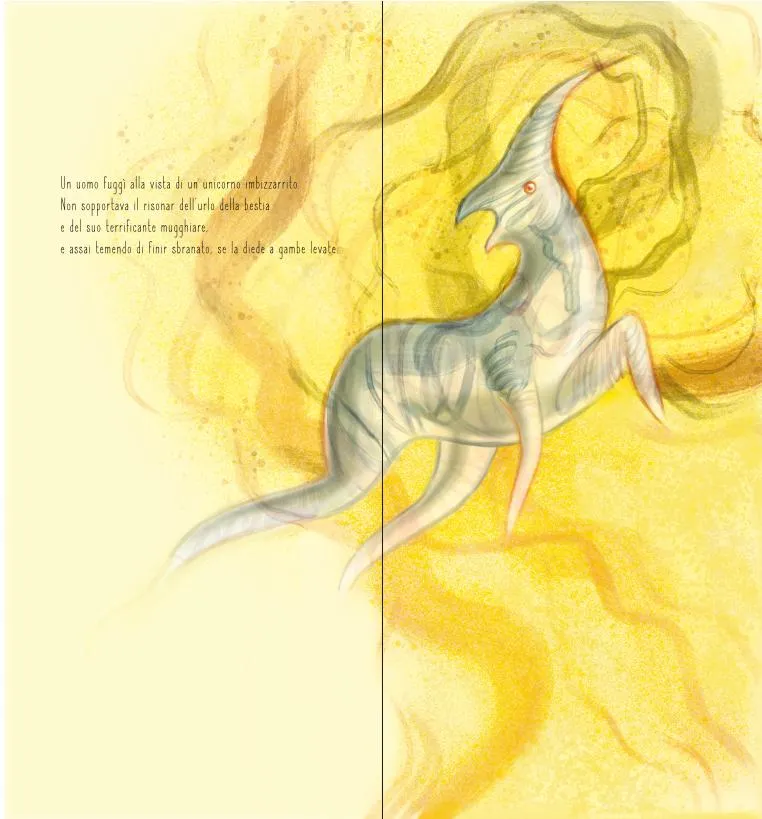
while running as fast as he could, he ended up in a well.
As he fell into it, he stretched out his hands and managed to grab onto a shrub,
to which he clung with all his strength;
found a foothold where he could put his feet;
He thought that from then on he could rest easy.
But when he took a good look, he saw two rats, One white and one black, which unceasingly gnawed at the root of the shrub to which he had clung,
were just on the point of cutting it clean off.
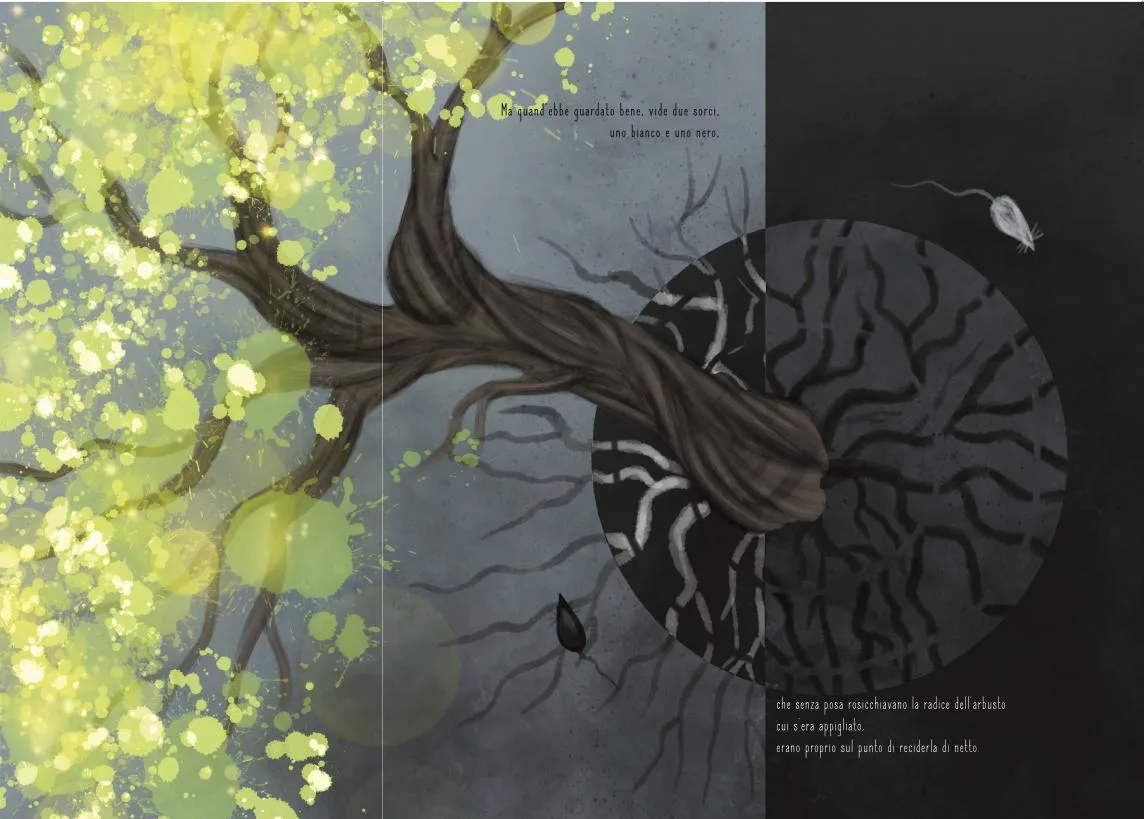
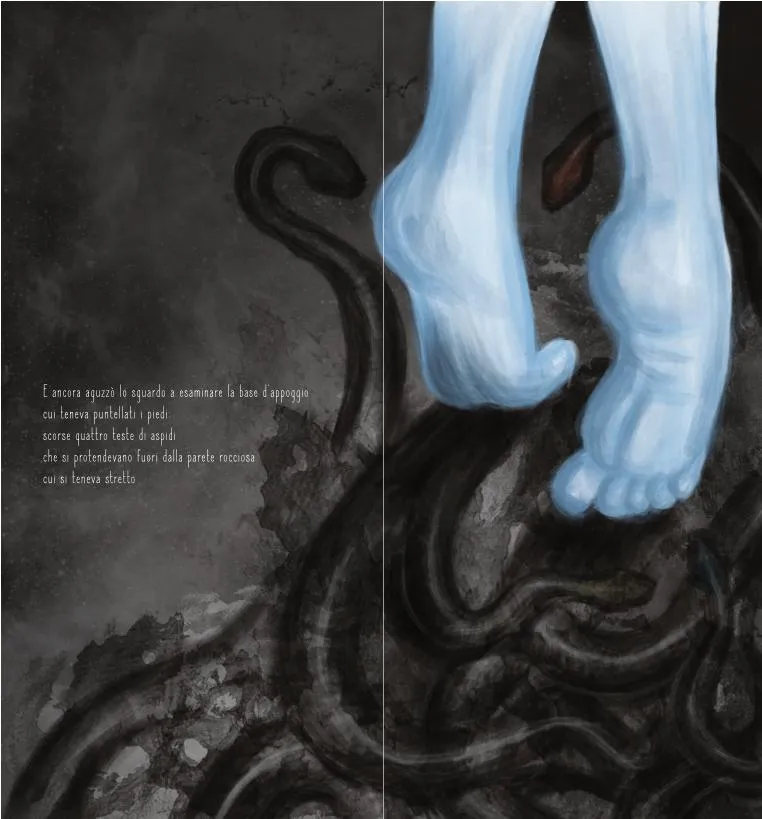
And still sharpened his gaze to examine the support base
to which he kept his feet propped:
he saw four snakes’ heads
stretching out from the rock face he was holding onto

Then he looked down the well…
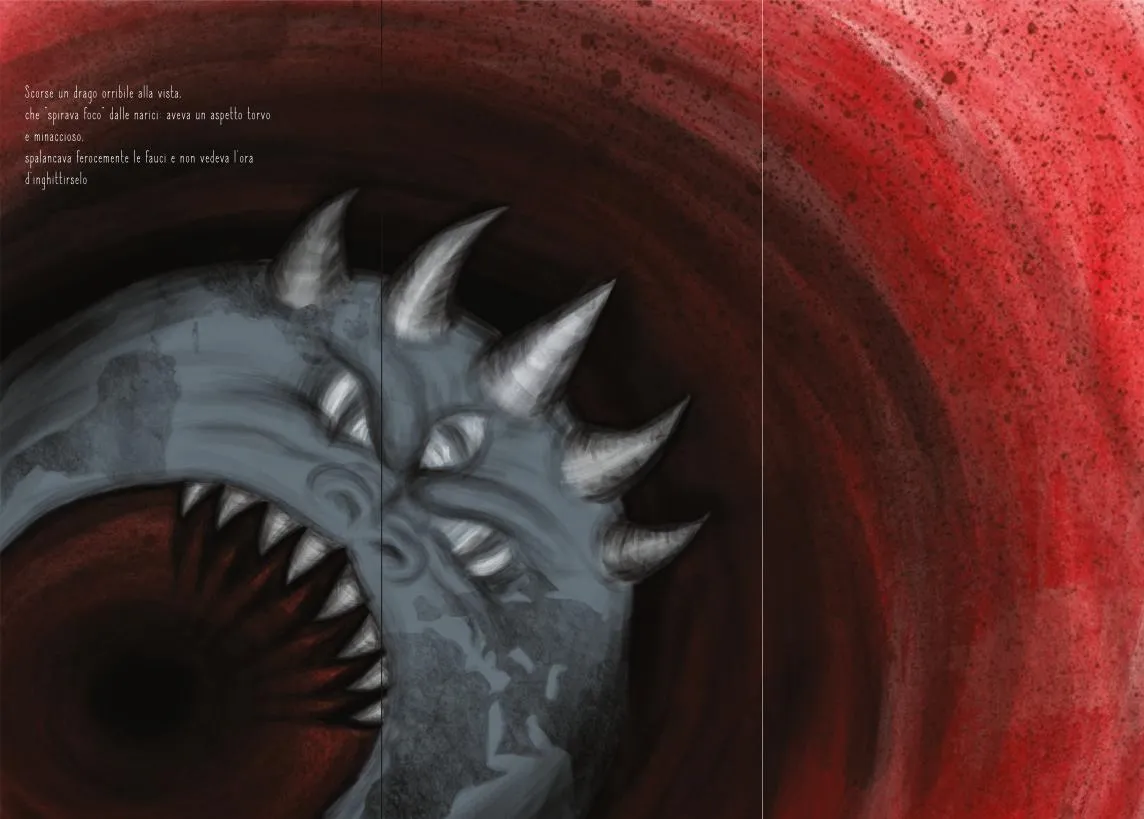
There arose a dragon hideous to the sight,
which ‘breathed fire’ from its nostrils: it had a grim and menacing appearance,
it opened its jaws fiercely and could not wait to swallow him up

Then he looked up,
saw that a few drops of honey were falling from the twigs of the shrub.

So he ceased to reason about the scourges around him
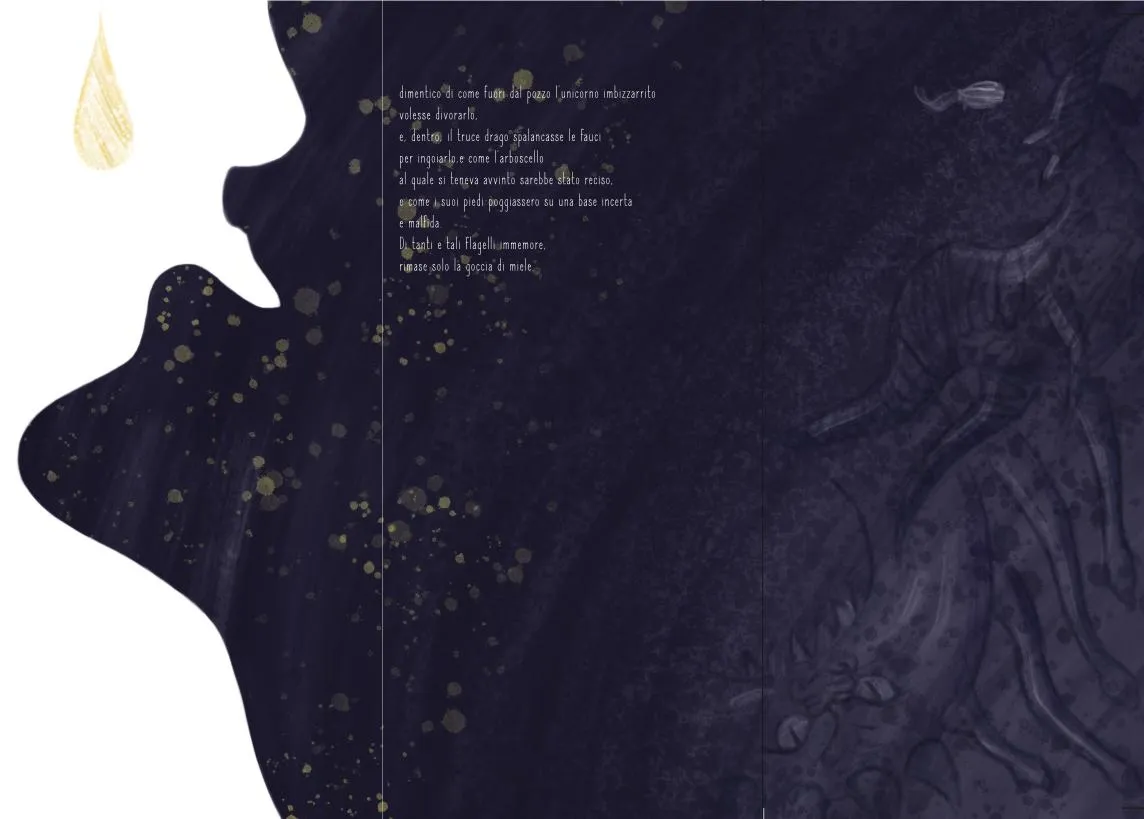
Forgotten how outside the well the unicorn was trying to devour him,
and inside, the grim dragon would open its jaws to swallow him, and how the bush he was clinging to would be severed,
and how his feet rested on an uncertain and malicious base.
Of so many and such scourges forgotten, only the drop of honey remained.

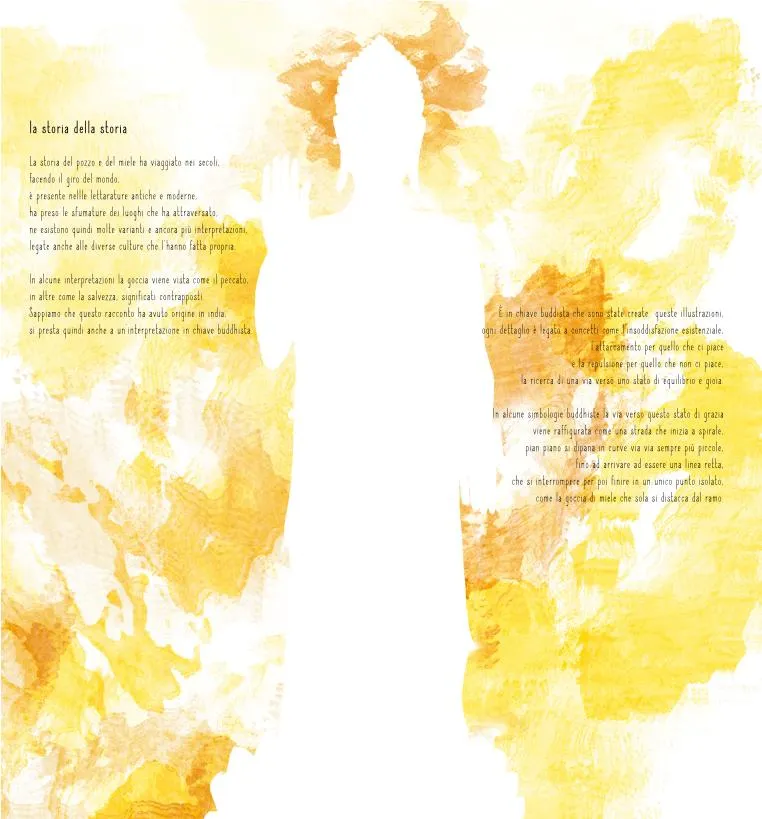
The story of the well and the honey has travelled through the centuries, touring the world, it is present in ancient and modern literature, it has taken on the nuances of the places it has passed through, there are therefore many variations of it and even more interpretations, also linked to the different cultures that have made it their own.
In some interpretations the drop is seen as sin, in others as salvation, opposing meanings.
We know that this tale originated in India, so it also lends itself to interpretation from a Buddhist perspective.
And it is in a Buddhist key that these illustrations were created, every detail is linked to concepts such as existential dissatisfaction, attachment to what we like and repulsion for what we do not like, the search for a way to a state of balance and joy.
In some Buddhist symbolism, the path to this state of grace is depicted as a road that begins as a spiral, gradually unravelling into smaller and smaller curves, until it becomes a straight line, which is interrupted and then ends in a single isolated point, like the drop of honey that alone detaches itself from the branch.
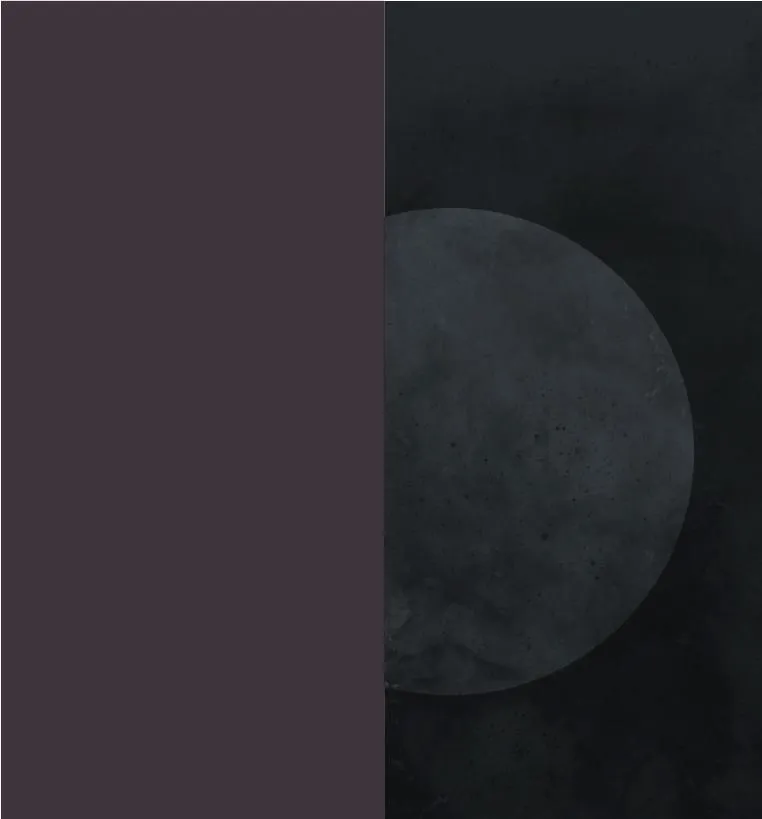
I hope you enjoyed this journey through time and space as much as I did!
It’s interesting how many different opinions there are about the meaning of the story, how many personalities throughout history have been fascinated by it, so I’m also curious about your idea, how would you interpret this parable? Let me know in the comments.
